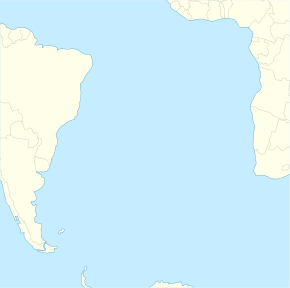
Back Tristan da Cunha Afrikaans Tristán da Cunha AN ट्रिस्टान द कुन्या ANP تريستان دا كونا Arabic تريستان دا كونا ARZ Tristan da Cunha AST Tristan-da-Kunya Azerbaijani Трыстан-да-Кунья (астравы) Byelorussian Тристан да Куня Bulgarian Tristan da Cunha Breton
Tristan da Cunha | |
|---|---|
| Motto: "Our faith is our strength" | |
| Anthem: "God Save the King" | |
| Territorial song: "The Cutty Wren"[citation needed] | |
 Map of Tristan da Cunha | |
Location of Tristan da Cunha archipelago (circled in red) in the southern Atlantic Ocean | |
| Sovereign state | |
| First settlement | 1810 |
| Dependency of Cape Colony | 14 August 1816[1] |
| Dependency of Saint Helena | 12 January 1938 |
| Current constitution | 1 September 2009 |
| Capital and largest settlement | Edinburgh of the Seven Seas 37°4′3″S 12°18′40″W / 37.06750°S 12.31111°W |
| Official languages | English |
| Ethnic groups | Mostly of British and Italian descent |
| Demonym(s) | Tristanian |
| Government | Devolved locally governing dependency under a constitutional monarchy |
• Monarch | Charles III |
• Governor | Nigel Phillips |
| Philip Kendall[2] | |
| James Glass[3] | |
| Legislature | Island Council |
| Government of the United Kingdom | |
• Minister | Stephen Doughty |
| Area | |
• Total | 207 km2 (80 sq mi) |
• Main island | 98 km2 (38 sq mi) |
| Highest elevation | 2,062 m (6,765 ft) |
| Population | |
• 2023 estimate | 238[4] |
• 2016 census | 293[5] |
• Density | 1.4/km2 (3.6/sq mi) |
| Currency | Pound sterling (£) (GBP) |
| Time zone | UTC±00:00 (GMT) |
| Date format | dd/mm/yyyy |
| Driving side | Left |
| Calling code | +44 20 (assigned +290) |
| UK postcode | TDCU 1ZZ |
| ISO 3166 code | SH-TA |
| Internet TLD | |
Tristan da Cunha (/ˌtrɪstən də ˈkuːn(j)ə/), colloquially Tristan, is a remote group of volcanic islands in the South Atlantic Ocean. It is one of three constituent parts of the British Overseas Territory of Saint Helena, Ascension and Tristan da Cunha, with its own constitution.[6]
The territory consists of the inhabited island Tristan da Cunha, which has a diameter of roughly 11 kilometres (6.8 mi) and an area of 98 square kilometres (38 sq mi); the wildlife reserves of Gough Island and Inaccessible Island; and the smaller, uninhabited Nightingale Islands. As of October 2018[update], the main island had 250 permanent inhabitants, who all carry British Overseas Territories citizenship.[7] The other islands are uninhabited, except for the South African personnel of a weather station on Gough Island.
There is no airstrip on the main island; the only way of travelling to or from Tristan is by ship, a six-day trip from South Africa.[8]
- ^ Crawford, Allan (1982). Tristan da Cunha and the Roaring Forties. Charles Skilton. p. 20. ISBN 9780284985897. Retrieved 13 August 2013.
- ^ Grundy, Richard. "Philip Kendall sworn-in as Tristan Administrator". www.tristandc.com. Archived from the original on 11 October 2023. Retrieved 2 October 2023.
- ^ "Tristan da Cunha Chief Islander". Tristan da Cunha Government & Tristan da Cunha Association. Archived from the original on 6 September 2014. Retrieved 11 October 2017.
- ^ Green, Cynthia. "Tristan da Cunha Population Update". www.tristandc.com. Archived from the original on 28 November 2019. Retrieved 28 November 2019.
- ^ "Census 2016 – summary report" (PDF). St. Helena Government. June 2016. p. 9. Archived from the original (PDF) on 17 October 2016. Retrieved 23 January 2017.
- ^ "The St. Helena, Ascension and Tristan da Cunha Constitution Order 2009". The National Archives. 2009. Archived from the original on 11 May 2011. Retrieved 5 January 2019.
- ^ "Tristan da Cunha Family News". Archived from the original on 21 November 2021. Retrieved 28 November 2021.
- ^ Corne, Lucy. "Tristan da Cunha: a journey to the centre of the ocean". Lonely Planet. Archived from the original on 5 June 2020. Retrieved 9 April 2020.


